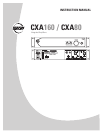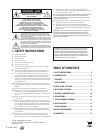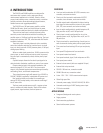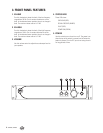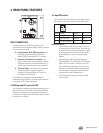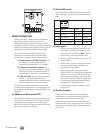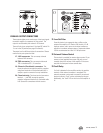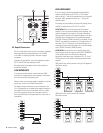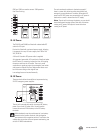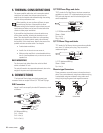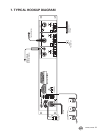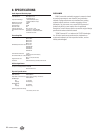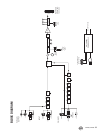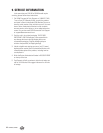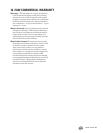
6 – CXA160 / CXA80
PRIORITY CONNECTORS
When a signal above –20 dB is detected at the priority
input, the main input is muted. This is useful for
making announcements, as the music program is then
automatically muted. This muting can also be accomplished
manually by connecting a user-supplied, normally open, dry
contact closure switch to the priority screw terminals.
The Priority input has four different styles of input
connections for microphone-level or line-level audio
signals. Choose one which suits your system the best:
11. Combination XLR/TRS connector.
This
can accept a male balanced XLR connector, a
balanced TRS or unbalanced TS 1/4" connector.
12. Phoenix (Euroblock) connector.
This
three-pin connector accepts the positive, negative
and ground terminals of a balanced audio line. It
accepts a push-in connector for easy installation.
13. Terminal strip. The three-terminal connectors
labeled +, –, and GND, accept the positive,
negative and ground terminals of a balanced audio
line. Secure the connections with the screws.
Each priority input style is designed to accept balanced
or unbalanced microphone-level, or line-level signals. The
priority input can be configured by means of the DIP-switch
(see below).
14. GAIN pot and OL (overload) LED
This screwdriver-adjustable rotary potentiometer acts as a
trim control, and a red indicator LED will light 3 dB before
clipping. With normal priority source material playing,
adjust the pot until the LED lights only occasionally during
the loudest moments of your program.
15. Priority DIP switch
This five-pole DIP-switch allows you to configure all four
priority input types, as shown in this table and described
below.
DIP switch details:
1. Mic/line (line-level is default). Select UP if using
a microphone, or DOWN if it is a line-level input
such as from a CD or DVD player. Note: You must
always set DIP 2 to the same setting as DIP 1.
2. Mic/Line. Set this to whatever DIP 1 is set to. See
above for details.
3. Phantom Power. Select UP if using a microphone
that requires phantom power, otherwise, it is
important to keep this DOWN.
4. High-pass filter enable. The default position is
enabled (DOWN). This rolls off the low frequencies
below 120 Hz, at a rate of 12 dB per octave. Use
this to reduce low frequencies, such as from low
bass notes, microphone handling and stage noise.
It is useful when using smaller speakers that do
not reproduce the low frequencies well.
5. 10 dB pad enable. Select UP to reduce the input
level by 10 dB.
16. Priority Terminals
Priority functions can be initiated by a user-supplied,
normally open, dry contact closure switch (or switches)
connected to the terminal strip (PRI GND, PRI 1).
Connecting one leg of the switch to the PRI GND screw
and the other side to PRI 1 prepares the circuit. Closing the
switch actuates the specific priority, allowing the priority
input to play.
DIP # Purpose DOWN UP
1 Mic/Line Line Level Mic Level
2 Mic/Line Line Level Mic Level
3 24 V Phantom OFF Enabled
4 High Pass Filter Enabled OFF
5 –10 dB Pad Enable OFF Enabled
11
15
14
12
13
16



